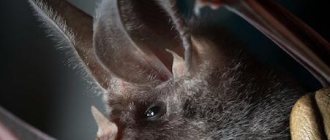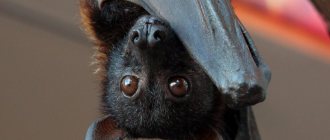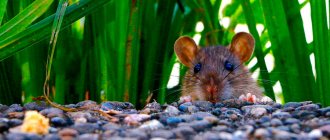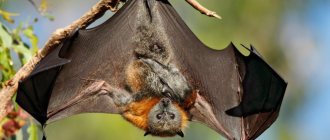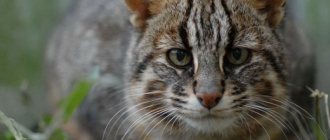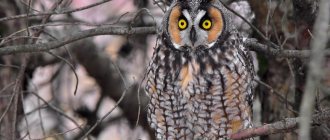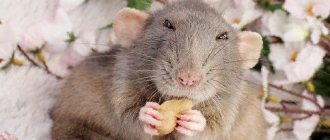Vampire bats are bats whose source of nutrition is blood. Unlike fruit-eating bats, vampires have a short, conical snout and no nasal plate. And the tip of the nose is equipped with special infrared receptors that allow them to find the place on the victim’s body where the blood flows closest to the skin. Vampire mice typically have small ears and a short tail. Their front teeth are well adapted for cutting skin, and their back teeth are much smaller than those of other species. The part of the bat's brain that processes sound is well suited to detect the uniform sound of the breathing of sleeping animals, whose blood is their main source of nutrition.
The little vampire, no bigger than a mouse, is causing serious problems for livestock farmers in Latin America. An ordinary vampire that feeds on blood is a carrier of rabies. In addition, fly larvae develop in ulcers on the bodies of animals that appear at the site of vampire bites.
REPRODUCTION
Common vampire bats differ from similarly sized mammals in the way they reproduce. They live a long time, reach sexual maturity late, and females, after pregnancy, which lasts 5-6 months, each time bring only one cub. The cub of an ordinary vampire is born blind and helpless. Spends the first days of its life on its mother's belly. However, the child grows quickly and soon becomes so heavy that the mother, flying off to hunt, leaves him in the shelter. At the age of one week, the cub's eyes open, and at three weeks it is already able to make its first flight.
Sharp-billed Ground Finch
The only bird on the list of 13 vampire animals is the sharp-billed ground finch. Finches typically use their beaks to obtain seeds on which to feed, and often abandon dry areas and move to more hospitable areas during the dry season. But one of its subspecies, the sharp-billed ground finch, remains to live on the Darwin Islands all year round, supplementing its diet with blood. Known as the “vampire finch,” it pierces the skin of other birds, mainly gannets, and quietly drinks the blood that flows from the wound.
LIFESTYLE
Ordinary vampires live in huge colonies, which often number up to 2000 individuals. During the day, they sleep in the hollows of old trees or in caves, hanging upside down. At dusk, these bats fly out to hunt. Pregnant females and females with cubs emerge a little earlier than males. Sometimes vampires leave the shelter later, under cover of darkness, fearing their enemies - the night predators. Another reason for the late departure of vampires is that by this time pets have time to fall into deep sleep and do not notice their approach. On bright moonlit nights, when the herds are left to graze in the meadow, vampires prefer to hole up in a shelter. It is possible that vampires find herds of cows and other domestic animals, guided by previously accumulated experience.
Sometimes vampire mice change their habits and fly away in search of new food sources that are closer to their places of residence. Vampires in flight stay near river beds and gorges. They navigate better in open areas than in the forest.
Chupacabra
The list of 13 vampire animals ends with the mysterious Chupacabra. While the existence of the previous 12 vampire animals is undeniable, the Chupacabra is more of a mythical creature than a real one. Although supposed sightings are common, its existence has not been documented.
After hundreds of dead, bloodless farm animals were found in Puerto Rico, the tale of the Chupacabra soon spread throughout the world.
Most captured chupacabras turned out to be rabid dogs or coyotes. But some people continue to claim that the Chupacabra is real and may have been left behind by space travelers, or even that it is a hybrid animal developed by NASA. Tags Animals Vampires Bloodsuckers
WHAT DOES IT EAT?
Vampire bats usually choose weak animals or those that have separated from the crowd as victims in a herd of cows, pigs or horses. Having chosen a victim and circling over it for a short time in the air, an ordinary vampire descends to the ground nearby. Using a special organ located near the nostrils, the vampire determines the temperature of various parts of the animal's body and looks for the place where the blood vessels pass close to the surface of the skin.
He sneaks up very carefully and silently, so the victim does not even suspect the danger that threatens him. The vampire cuts off the skin in the chosen place with incisors and makes grooves in the wound with sharp fangs. Vampires make cuts, usually in the neck and shoulders, as well as on the rump and near the joints.
Vampire saliva contains an enzyme that relieves pain and at the same time prevents blood clotting. It penetrates the wound, which then bleeds for a long time, allowing the vampire to lick off the oozing blood. The vampire carries out all the actions he needs in literally a matter of seconds.
Ticks
Continuing the list of 13 animal vampires are mites, which are among the most prolific vampires on Earth, capable of drinking 600 times their own body weight thanks to the amazing ability to stretch their outer shell. They prefer warm forest areas near water. They have special tactics for searching for food: some wait in tall grass, while others hunt for their hosts. Of course, a tick bite will not turn you into a vampire, but it can cause such a serious illness as Lyme disease.
VAMPIRE AND HUMAN
Vampires pose a danger to pets because they carry rabies. The rabies virus in vampires can be kept alive for up to 10 months. As a means to fight vampires, animals are injected with a special substance that prevents blood clotting and causes internal bleeding in vampires who parasitize such animals. A similar substance is rubbed into the fur of captured vampires. Vampires help spread chemicals among their own kind while brushing their fur together.
Lice
Like fleas, lice are external parasites that live on their hosts. The problem of head lice is no longer as acute as it used to be. But body lice are the only ones that spread disease. Typhoid, typhus and relapsing fever can be transmitted by these lice, although such diseases are mainly found among homeless people or those who do not have access to regular bathing or a change of clean clothing.
INTERESTING INFORMATION. DID YOU KNOW THAT...
- Vampire bats are more likely to attack calves than adult cows—calves sleep more and have thinner skin.
- They say that vampires drink the blood of people who, upon awakening, notice wounds.
- Bats navigate in space using radiation and perception of high-frequency sound signals, thanks to which vampires can fly in the dark, avoiding collisions with obstacles.
- In the past, ordinary vampires fed only on the blood of wild animals, but today they often attack livestock.
Kissing bugs
Their name may not seem very scary, but kissing bugs are much worse than bed bugs. They are larger and more aggressive, for example, often biting people in the face. Kissing or triatomine bugs attack while you sleep, but unlike bed bugs, they can also spread disease, namely the parasite that causes Chagas disease. Their bites can stimulate allergic reactions, including swollen eyes, blistered skin, difficulty breathing and even seizures.
VAMPIRE EATING SKILLS
Vampires feed exclusively on the blood of mammals, mainly ungulates, which they drink from wounds - areas of skin cut off by sharp incisors on the neck, ears, back and joints of animals, where blood vessels pass close to the surface.
A vampire's tongue has two grooves along which blood alternately flows. Blood enters the mouth along the forked lower lip. Vampire saliva contains a special enzyme that prevents blood clotting. The daily blood requirement for an adult vampire is 22 ml - approximately 5 teaspoons.
— Habitat of an ordinary vampire bat
WHERE DOES HE LIVE?
The vampire inhabits tropical and subtropical regions of Central and South America from Mexico to Argentina and Chile.
PRESERVATION
Vampires cause serious damage to livestock. They are carriers of rabies and other dangerous diseases. Attempts to influence the number of vampires end in failure.
Recommendations
- ^ a b
Barques, R., Perez, S., Miller, B., & Diaz, M. (2015).
Desmodus rotundus
. IUCN Red List of Threatened Species 2015. doi:10.2305/IUCN.UK.2015-4.RLTS.T6510A21979045.en - Geoffroy, E. (1810). "Sur les Phyllostomes et les Mégadermes, deux Genres de la famille des Chauve-souris." Annales du Muséum d'histoire naturelle
.
G. Dufour, et Ed. d'Ocagne. 15
: 181. - ^ a b c d f g gram h i j k l m p
Greenhall, AM;
Joermann, G.; Schmidt, W. (1983). "Desmodus rotundus" (PDF). Species of mammals
.
202
(202):1–6. Doi:10.2307/3503895. JSTOR 3503895. - Weed, M. (1826). Beiträge zur Naturgeschichte von Brasilien /
.
2
. Weimar: Im Verlage des Landes-Industrie-Comptoirs. pp. 231–238. - Wilson, Don E. and Reeder, DeeAnn M. (editors). (2005). Species of mammals of the world.
Taxonomic and Geographical Reference (3rd ed.), Johns Hopkins University Press. ISBN 9780801882210 - Thomas, O. (1901). "List of Mammals Obtained by Dr. J. Franco Grillo in the Province of Paraná, Brazil." Annali del Museo Civico di Storia Naturale di Genova
.
2. Advice. del R. Sordo-Muti Institute. 40
: 546–549. - ^ a b c
Eisenberg, John F;
Redford, Kent Hubbard (1992). Mammals of the Neotropics, Volume 3
. University of Chicago Press. pp. 187–88. ISBN 978-0-226-19542-1. - ^ a b
Greenhall, AM;
Schutt Jr., W. A. (1996). "Diemus the Young" (PDF). Species of mammals
.
533
(533):1–7. Doi:10.2307/3504240. JSTOR 3504240. Archived from the original (PDF) on 2014-05-24. Retrieved 2011-11-29. - Greenhall, A.M.; Joermann, G.; Schmidt, W. (1984). "Diphylla ecaudata" (PDF). Species of mammals
.
227
(227):1–3. Doi:10.2307/3504022. JSTOR 3504022. Archived from the original (PDF) on 2014-05-24. Retrieved 2011-11-29. - Ritter, Jana; Smedley, Rebecca and Benirschke, Kurt. "Vampire bat Desmodus rotundus murinus
." Diagnostic Center for Animal Population and Health, University of Michigan.CS1 maint: multiple names: list of authors (link) - Orihuela, Johanseth (2011). "Vampire bat skull variant Desmodus rotundus
(Chiroptera: Phyllostomidae): Taxonomic implications for the Cuban fossil vampire bat
Desmodus puntajudensis
."
Neotropical chiropterans
.
17
(1):863–876. ISSN 2317-6105. Archived from the original on 2018-06-18. Received 2019-07-31. - Vampire bats may expect a large meal or none at all. socialbat.org (08/31/2015).
- ^ a bc Riskin
, Daniel K.;
Hermanson, John W. (2005). "Biomechanics: Independent evolution of running in vampire bats". Nature
.
434
(7031): 292. doi:10.1038/434292a. PMID 15772640. S2CID 4406312.video - Altenbach, J. S. (1979) "Locomotor morphology of the vampire bat, Desmodus rotundus
",
Special Publication (American Society of Mammalogists)
, no. 6. - Schutt, W. A. Jr.; Hermanson, J.W.; Chang, Y. H.; Cullinane, D.; Altenbach, J.S.; Muradali, F.; Bertram, J. (1997). “Dynamics of starting jumps of the common vampire bat. Desmodus rotundus
".
Journal of Experimental Biology
.
200
(23):3003–12. PMID 9359889. - ^ a b
Schmidt U., Schmidt C. (2007).
"Echolocation display of the vampire bat ( Desmodus rotundus
)".
Z Tierpsychol
.
45
(4): 349–58. Doi:10.1111/j.1439-0310.1977.tb02025.x. PMID 610226. - Traiano, E. (1996). "Movements of cave bats in Southeast Brazil with emphasis on the population ecology of the common vampire bat, Desmodus rotundus
(Chiroptera)."
Biotropica
.
28
(1): 121–29. Doi:10.2307/2388777. JSTOR 2388777. S2CID 52060593. - ^ a b c d f g gram h i j
Lord, R. D. (1993).
"A Taste of Blood: A highly specialized vampire bat won't dine on anything else." Wildlife Conservation
.
96
: 32–38. - ^ a b c
Wilkinson, G.S.
(1985). "Social organization of the common vampire bat 1: pattern and cause of association." Behav.
Ecol. Sociobiol .
17
(1): 111–21. Doi:10.1007/BF00299243. JSTOR 4599814. - ^ a b
Wohlgenant, T. (1994).
"Interactions between caged common vampire bats ( Desmodus rotundus
) and two carnivorous bats (
Bleaching phyllostomus
and
Sturnira lily
) in Guanacaste, Costa Rica."
Biotropica
.
26
(3): 344–48. Doi:10.2307/2388857. JSTOR 2388857. - ^ a b c
Wilkinson, J. (1990).
"Food Sharing in Vampire Bats" (PDF). Scientific American
.
262
(21):76–82. doi:10.1038/scientificamerican0290-76. Archived from the original (PDF) on 2012-03-06. Retrieved 2011-09-11. - Schutt, W. A. Jr.; Muradali, F; Mondol N; Joseph, K; Brockmann, K. (1999). "Behavior and captive management of white-winged vampire bats, Diaemus youngi
."
Journal of Mammology
.
80
(1):71–81. Doi:10.2307/1383209. JSTOR 1383209. - ^ a b c d
Wilkinson, J. (2001) "Bat Blood Donors", pp. 766-767 in
Encyclopedia of Mammals.
Facts about the file . Ed. D. McDonald and S. Norris. ISBN 0-87196-871-1 - ^ a b c d f f
Nowak, R. M. (1991)
Walker's Mammals
. pp. 1629. Johns Hopkins Press. ISBN 0-8018-3970-X - ^ a b
Michael Mulhaysen; Anderson, Rebecca. "Desmodus rotundus". Animal Diversity Network. Retrieved December 16, 2011. - ^ a b c d e
Wilkinson, G.S.
(1985). "Social organization of the common vampire bat II: mating system, genetic structure, and relatedness" (PDF). Behav.
Ecol. Sociobiol .
17
(2): 123–34. ISSN 0340-5443. - ^ a b c d e
Carter, G. G.;
Wilkinson, G. S. D. (2013). "Does Food Sharing Demonstrate Reciprocity in Vampire Bats?" Comm Integ Biol
.
6
(6):e25783. Doi:10.4161/cib.25783. PMC 3913674. PMID 24505498. - ^ a b
Wilkinson G. S. (1986).
"Social grooming in the common vampire bat, Desmodus rotundus
" (PDF).
Anim.
Behavior .
34
(6): 1880–1889. CiteSeerX 10.1.1.539.5104. Doi:10.1016/s0003-3472 (86) 80274-3. S2CID 11214563. - ^ a b c d
CDC (April 22, 2011). "Let's learn about bats and rabies." Retrieved December 5, 2011. - Bat Facts Smithsonian Institution. Retrieved April 6, 2011.
- ^ a b
Joseph Lennox Pavan Archived 2016-03-04 at the Wayback Machine, Caribbean Council for Science and Technology. Retrieved April 1, 2011 - Constantine, Denny G. (April 1962). "Transmission of rabies without bites." Public Health Reports
.
77
(4):287–289. Doi:10.2307/4591470. JSTOR 4591470. PMC 1914752. PMID 13880956. These data support the consideration of an airborne medium, such as aerosol, as a mechanism of rabies transmission in this case. - Messenger, Sharon L.; Jean S. Smith; Charles E. Ruprecht (2002-09-15). "New epidemiology of latent bat-associated rabies cases in humans in the United States." Clinical infectious diseases
.
35
(6):738–747. Doi:10.1086/342387. PMID 12203172. Latent rabies cases are those in which a reliable history of exposure to the rabies virus cannot be documented despite extensive medical history review. The lack of a documented bite history reflects the inherent difficulty in obtaining accurate information about animal exposures…. Thus, the absence of bite history data does not mean that the bite did not occur. - Liberatore, G.T.; Samson, A.; Bladin, C.; Schleuning, W.; Medcalf, R. (2003). “Vampire bat salivary plasminogen activator (desmoteplase) is a unique fibrinolytic enzyme that does not promote neurodegeneration” (PDF). Iron
.
34
(2):537–43. Doi:10.1161 / 01.str.0000049764.49162.76. PMID 12574572. S2CID 627965.
Favorite places to settle
Where do bats live? Since they are nocturnal and crepuscular animals, they need a secluded and safe daytime shelter.
Depending on the size and structural features of the limbs, it directly depends on where the bat lives. These animals choose the most suitable ready-made natural shelters for them - caves and rock crevices, depressions in the walls of cliffs and the slopes of dunes, hollows and holes left by their inhabitants.
Some tropical species build improvised umbrella huts from large leaves, gnaw out personal niches in bundles of palm fruits, or climb into the voids between the nodes of bamboo trunks.
Human encroachment into nature is destroying the natural habitats of bats; many of their species are becoming rare and disappearing. However, the bat's adaptability to its habitat is very high and, in the vicinity of people, bats try to discover new shelters for themselves, similar to their favorite caves, burrows, hollows and crevices.
In Egypt, they mastered the internal labyrinths of the great pyramids, in abandoned mines and adits in exhausted mining areas, in cities and villages they inhabit attics, basements, cellars, haystacks, woodpiles, and sneak behind shutters and under window frames.
Information: Representatives of most species prefer to settle in large colonies.
To attract bats in gardens and farms, special houses made of slats with a secluded lower entrance - a narrow slot, similar to inverted mailboxes - are hung on trees at a height of at least 3 meters.
general description
These are rather small bats: their body length does not exceed 9 cm with a mass of 40 g and a wingspan of 32-35 cm. There is no tail; the interfemoral membrane is narrow. The muzzle is short, conical, without a nasal leaf. The nostrils are surrounded by skin ridges. At the end of the nose, vampires have specialized infrared receptors that allow them to find warm-blooded prey. The ears are small, pointed, and not connected to each other. There is a tragus. The color of the hair is uniform, brownish; White-winged vampires have white wing edges.
Vampires' teeth are adapted to their specific diet. The upper incisors are very large, fang-shaped, with sharp cutting edges capable of cutting the skin of the victim. The lower jaw is longer than the upper jaw, and when the jaws close, the tips of the upper incisors fit into deep grooves on the inside of the lower jaw behind the lower incisors. The fangs are large. The premolar teeth are narrow, with sharp edges. Molars are absent or very poorly developed. The digestive system is adapted to hematophagy - vampires have a very short esophagus, and the stomach is equipped with a large intestinal outgrowth.
Torpedo snail
Perhaps the most atypical vampire is Cancellaria Cooperi, a species of sea snail that feeds almost exclusively on the blood of electric rays. True to its name, this relative of the stingray can produce up to 220 volts to paralyze both prey and predator, but parasites are a different matter.
Slow but persistent, the little snails can smell the slimy coating from several feet away and use a long, thin tube to suck out blood without causing any pain or discomfort to the fish.
Kandiru
This tiny Amazonian relative of the catfish is notorious for its habit of spending time in the urethra of large mammals (like humans) stupid enough to urinate in river water. This accident is on Kandir's conscience, since by mistake the stream of urine is perceived by these creatures as a stream of water from the gills of a larger fish.
Their thin, stunted bodies and tiny beards are specially adapted to live in the full-blooded fish gills, where once trapped they use their tiny jaws to bite into the vessel and celebrate the fish party.
Lampreys
Once upon a time there were “jawless fish” that appeared millions of years ago on a planet dominated by mollusks and other arthropods. Today, only their ancestors exist, which are the mucus-eating hagfish (very fascinating creatures, but not hematophagous) and the suction-cup-mouthed lampreys. Many species of lampreys are quite harmless, but among them there are also some rather unpleasant parasites.
By attaching themselves to other fish, they scrape away flesh until they reach blood or other body fluids, which can be fatal to the host if it is not large enough to easily recover. Although seemingly primitive and disgusting, lampreys are considered exemplary mothers, migrating far to spawn and carefully placing rocks in their nests to protect their young.
Adaptation to the characteristics of the environment
Chiroptera creatures demonstrate amazing adaptability to the most extreme temperature conditions. They can withstand both an increase in body temperature up to 40 degrees and a decrease to zero.
The feeding methods of winged animals are also very diverse and correspond to the environment in which they live and reproduce.
The main contrasts occur in the tropical zone, where some species consume purely vegetarian flower nectar and fruit pulp, while others consume the blood of larger mammals. However, the majority of bats prefer to hunt insects. In rare cases, small vertebrates such as frogs and songbirds become their prey.
REFERENCE. The benefits that bats bring to farm crops were clearly demonstrated by an experiment conducted in the USA: a part of a corn field covered with a net, over which night flyers could not hunt, suffered 56% more damage from the caterpillars of pest butterflies.
In the middle zone, bats hunt insects in large numbers in summer. During the night, one animal destroys up to a thousand mosquitoes, as well as numerous pests of fields, gardens and vegetable gardens, whose flight occurs at night.
With the approach of cold weather and the disappearance of their main food, bats look for a winter shelter, the temperature in which should not fall below 0ºC, and fall into suspended animation.
So these amazing creatures survive an unfavorable season in the environment to which they have managed to adapt perfectly.
Awakening comes in the spring, when the first flying insects appear - and the tireless flyers again go out on night watch.
Mass destruction of insect pests in the dark, when birds are inactive, brings undoubted benefits to gardening and farms. If you provide bats with suitable shelter houses, the winged animals will take up residence in them and will work properly instead of insecticides.
Bats often become unwanted neighbors of humans, settling in the attics and balconies of houses and apartments. Some people do not consider it necessary to kick out guests, but such a neighborhood has more disadvantages than advantages. If you decide to get rid of them, do not forget that some of their species are listed in the Red Book and their destruction is prohibited. Therefore, be patient and achieve the peaceful relocation of bats to more suitable places for them.
White bat
The tailless or Honduran white mouse has one of the smallest dimensions of the entire flying family, only up to 4.5 cm in the body. The animal’s ears are also small, its nose has an unusual shape and important functions: it is an echolocator, that is, it focuses and amplifies the signals sent.
The habitat of the white mouse is not limited to Honduras. She also lives in Central American countries (Costa Rica, Nicaragua, Panama). For living, they use the heliconia plant, gnawing holes in it so that the hanging ends form a kind of umbrella. Diet: fruits.
They form families of 5-6 heads, but can also create numerous clans. They breed once a year. One female gives birth to only one calf.
